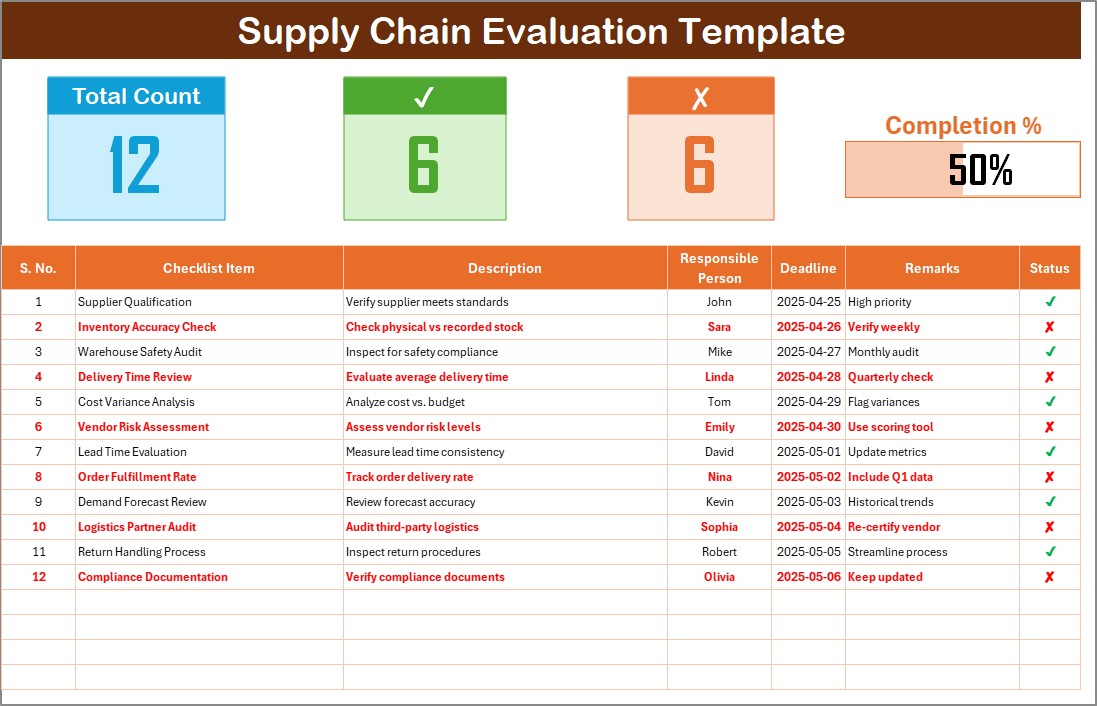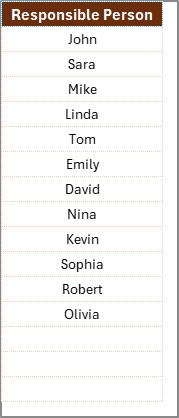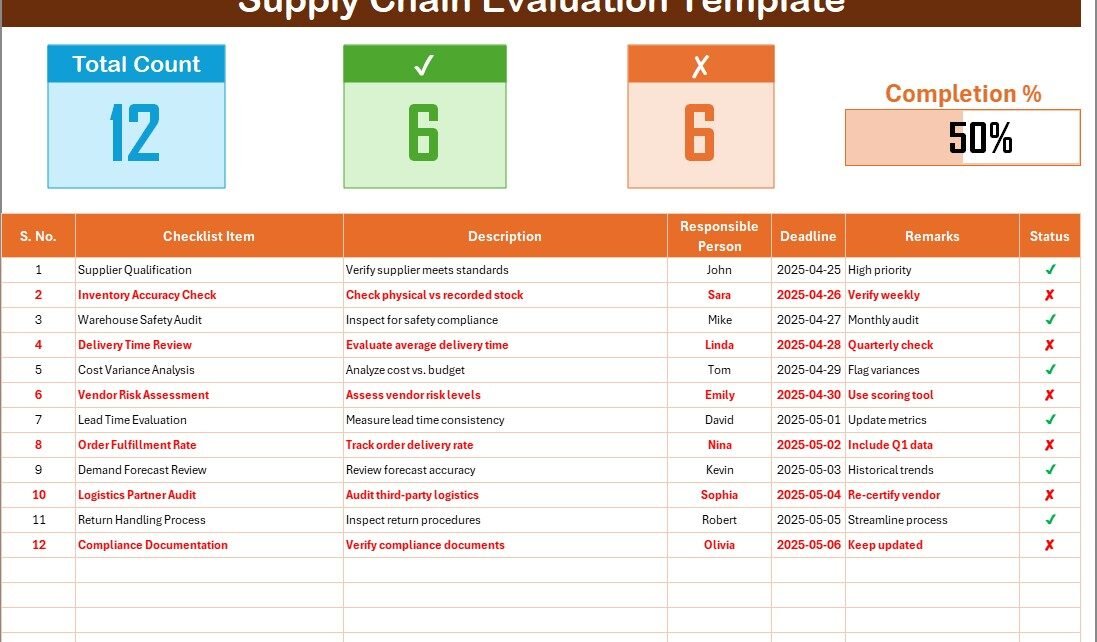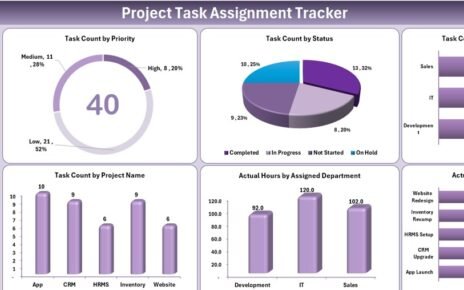Evaluating your supply chain operations doesn’t have to be complicated or time-consuming. In fact, with the right tools, it becomes not only easier but also more effective. One such powerful yet simple tool is Microsoft Excel.
Whether you are a logistics professional, supply chain manager, or business owner, using a Supply Chain Evaluation Checklist in Excel can help you ensure that every link in your supply chain runs smoothly.
In this comprehensive guide, we’ll walk you through everything you need to know about Supply Chain Evaluation in Excel, including:
- Why it’s important
- How the Excel template works
- Key advantages
- Best practices for using the template
- Frequently asked questions (FAQs)
Let’s dive in!
Click to Purchases Supply Chain Evaluation in Excel
What Is Supply Chain Evaluation?
Before we get into Excel, let’s understand the concept.
Supply chain evaluation refers to the process of assessing all the key areas in your supply chain—such as suppliers, logistics, procurement, inventory, warehousing, and distribution—to determine how well they are performing.
This evaluation helps you:
- Identify risks
- Improve efficiency
- Ensure compliance
- Optimize cost and delivery times
Now imagine doing all this in a structured, checklist-style format using Excel. That’s where the Supply Chain Evaluation Checklist Template comes in handy.
Why Use Excel for Supply Chain Evaluation?
While there are many fancy tools in the market, Excel remains one of the most preferred tools due to its flexibility, accessibility, and ease of use.
Here’s why Excel is a great option:
✅ Available on almost every computer
✅ Easy to customize and adapt to your organization’s needs
✅ Allows quick data entry and visual tracking
✅ Works offline and doesn’t require any coding skills
Now let’s explore the Excel template we’ve designed for supply chain evaluation.
Overview of the Supply Chain Evaluation Excel Template
We have created a ready-to-use Supply Chain Evaluation Checklist Template in Excel that simplifies the entire process.
The template consists of 2 well-structured worksheets:
Supply Chain Evaluation Checklist Sheet

This is the main working sheet of the template. It includes the following sections:
Top Section (Summary Cards)
This area gives you a snapshot of your progress:
- Total Count – Total number of checklist items
- Checked Count (✔) – Number of completed or compliant items
- Crossed Count (✘) – Number of non-compliant items
- Progress Bar – A dynamic bar that shows the percentage of completed items
Checklist Table
This is where the actual evaluation happens. It includes:
- Serial No. – Automatically filled or manually entered
- Checklist Item – What exactly needs to be evaluated
- Description – Short explanation of the item
- Responsible Person – Who’s accountable
- Deadline – When it should be completed
- Remarks – Any comments or observations
- Status – ✔ (Completed) or ✘ (Not Completed)
With this structure, you can review, assign, track, and finalize supply chain tasks in one view.
List Sheet Tab

- This sheet holds the unique list of responsible persons, which is used to create a dropdown in the main checklist.
- This makes data entry faster and prevents spelling mistakes or duplication.
Advantages of Using Excel for Supply Chain Evaluation
Now that you know how the template works, let’s explore why this approach is so effective:
✅ Simple Yet Powerful: The template is built on Excel, which means anyone with basic spreadsheet knowledge can use it effectively. No need to learn a new tool.
✅Enhances Accountability: Assigning a Responsible Person for each checklist item ensures clear accountability. This is especially useful when managing multiple departments.
✅Improves Transparency: The summary cards and progress bar offer instant insights into how the evaluation is progressing. You don’t have to scroll through hundreds of rows to know the status.
✅Customizable: You can easily modify the checklist items, add columns, or change the format based on your specific needs.
✅Time-Saving: With dropdowns, auto-calculations, and a clean format, you can evaluate your entire supply chain in a fraction of the time it would take using traditional methods.
Best Practices for Using Supply Chain Evaluation in Excel
To get the most out of your Excel template, keep these best practices in mind:
🔸 Keep Checklist Items Clear and Specific: Avoid vague items like “Check Inventory.” Instead, say “Verify inventory levels for SKUs above reorder point.”
🔸 Use Deadlines Wisely: Set realistic but firm deadlines for each item to encourage timely action.
🔸Review Regularly: Don’t treat the checklist as a one-time task. Make it a monthly or quarterly review process to stay updated.
🔸Update the Responsible Person List: As your team changes, update the names in the List tab to keep dropdowns accurate.
🔸 Store Version History: If you’re evaluating periodically, keep multiple copies (e.g., Q1 Evaluation, Q2 Evaluation) for future reference.
Conclusion
Evaluating your supply chain is no longer a task that requires complex tools or software. With the Supply Chain Evaluation Checklist in Excel, you can monitor key areas, assign accountability, and keep everything on track—all in one file.
Frequently Asked Questions (FAQs)
❓What is a supply chain evaluation checklist?
A supply chain evaluation checklist is a structured list of tasks, assessments, or reviews designed to analyze different parts of the supply chain such as vendors, inventory, delivery, logistics, and risk management.
❓Can I customize the Excel checklist template?
Yes, you can. You can edit checklist items, add or remove columns, change formatting, and update names as needed.
❓What are the benefits of using Excel over supply chain software?
Excel is more affordable, flexible, and easier to use. Unlike costly software, Excel doesn’t require advanced training and works perfectly for small to medium-sized businesses.
❓How often should I perform a supply chain evaluation?
It depends on your industry, but ideally, you should perform it every quarter or at least twice a year to catch inefficiencies and areas of improvement.
❓Is this template suitable for large organizations?
Yes! While it’s simple enough for small businesses, you can scale it up by adding more checklist items, departments, and users. It’s very versatile.
❓Can I track progress visually in the Excel file?
Absolutely. The top section includes summary cards and a progress bar that updates automatically as you complete tasks.
Click to Purchases Supply Chain Evaluation in Excel
Visit our YouTube channel to learn step-by-step video tutorials



